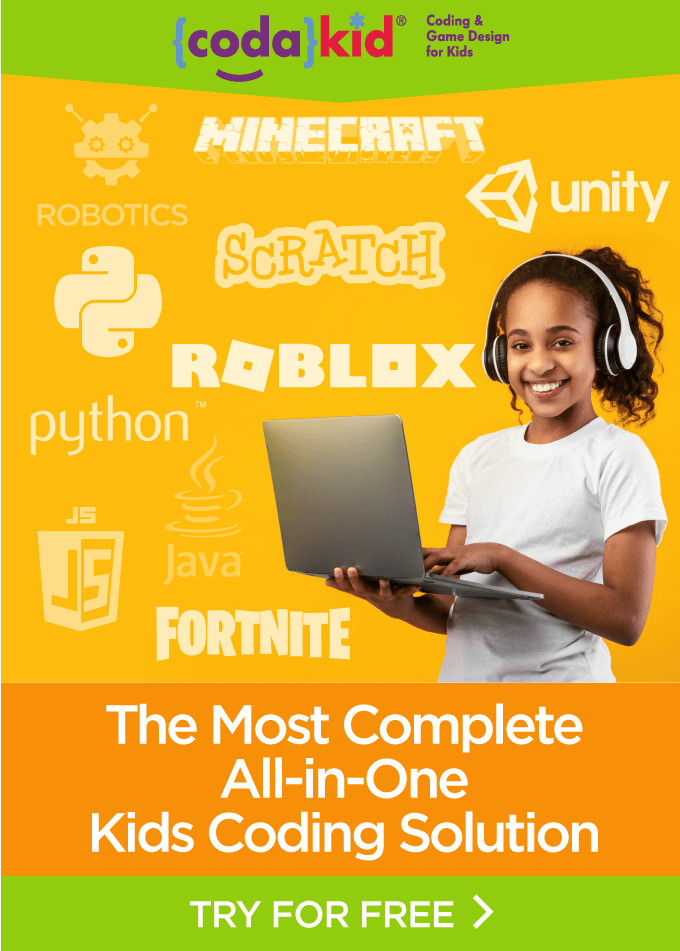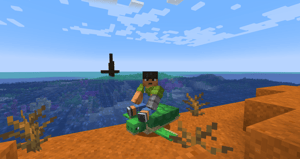Age 14 is a perfect age to learn computer programming. For one, 14-year-old students have several advantages in learning coding than their younger counterparts. Their schooling has introduced them to basic algebra, making it easy to grasp the math involved in computer programming, most notably algorithms.
Secondly, they will better grasp multi-step problem solving and have usually developed keen attention to detail. Lastly, many 14-year-olds are often interested in various projects, including websites, apps, and other vocationally oriented projects that will help them build valuable 21st-century skills, possibly preparing them for jobs that don’t even exist yet.
At CodaKid, we have taught coding to 14-year-olds for over 10 years and have created an award-winning curriculum taught to tens of thousands of students worldwide. We hope that you’ll find our experience helpful.

Table of Contents
Tips to Teach 14-Year-Olds How to Code Effectively
Now that we understand why the age of 14 is an opportune time to introduce young minds to the world of coding, let’s explore some key strategies for effective teaching. These tips are designed to engage, inspire, and empower 14-year-olds on their coding journey.
By following these guidelines, educators and parents can help create a nurturing environment where young learners thrive.
1) Use a Project Based Learning (PBL) Approach
Most computer programming degree tracks for adults teach computer programming and its concepts in isolation. While this approach works for adults in academic or vocational settings, it isn’t as effective for 14-year-olds. In our experience, it is acceptable to teach kids coding concepts in isolation, but to keep them engaged and interested, it is essential to show them how to use the concepts right away in a meaningful project.
Project Based Learning (PBL) is a style of pedagogy in which students explore real-world problems and challenges and acquire transferable knowledge. An example of PBL in the coding space could be building a 2D RPG game using Pygame with Python or building an actual website about the student’s favorite hobby using HTML, CSS, and JavaScript. Projects like these allow students to learn coding concepts and practice using professional programming languages and tools while building high-interest projects.
2) Move to Real Programming Languages as Quickly as Possible
If your student has never programmed before, beginning with visual block platforms such as Scratch is always advisable to learn coding basics without getting burdened by text-based coding languages and editors. We learned that the Massachusetts Institute of Technology (MIT) uses Scratch to teach a section of its Computer Science 101 course, a testament to how well-respected Scratch is as an educational tool.
However, if you keep 14-year-olds on Scratch for too long, many will find Scratch too “kid-oriented” and want to experience actual programming with professional languages and tools. Fortunately, there are many accessible and beginner-friendly text-based programming languages out there. Our favorites are Python, JavaScript, and Lua, which can be used for various projects ranging from games to apps to websites.
3) Tailor the Instruction to Their Interests
Many 14-year-old coders will want to build video games, and it’s no wonder because Approximately 3 billion people worldwide play video games. So, at CodaKid, we think this pursuit should be encouraged. Game programming will teach 14-year-olds foundational coding concepts such as conditionals, variables, functions, loops, etc.
Game development will also help them learn about using art assets like sprites and models and naturally teach them about problem-solving and debugging. I always encourage parents to never look upon game development as a lesser form of programming but instead, teach them how transferable the many skills students will gain from it.
4) Make it Creative
Computer programming is a creative activity, and unfortunately, many coding curriculum providers don’t introduce the creative component early and often. Instead, we find many “on rails” style coding challenges that sometimes include problem-solving but don’t allow students to build their own creations.
For example, even an “on-rails” coding curriculum might provide a problem where students are asked to calculate the area of a rectangle or simulate a basic calculator. While these exercises can be valuable for building foundational skills, they often lack the spark of creativity that can truly ignite a young coder’s passion.
To address this gap, it’s essential to encourage creativity in coding from the outset. Here’s why:
- Inspires Innovation: Creative coding challenges encourage students to think outside the box. When young coders are free to explore their ideas and build their own projects, they’re more likely to stumble upon unique solutions and innovative concepts.
- Fosters Ownership: When students create something of their own, whether a game, a website, or a mobile app, they take ownership of their work. This sense of ownership can boost their self-confidence and motivation to learn.
- Practical Application: Creative coding projects often mirror real-world scenarios. Whether designing a personal blog, developing a mobile game, or automating a task, students can see the direct application of their skills, making learning more meaningful.
- Fun and Engagement: Let’s face it; coding should be fun! When students are free to unleash their creativity, coding becomes an enjoyable and rewarding experience. It’s a chance to turn their imagination into reality through lines of code.
Recommended Programming Areas of Study
As 14-year-olds embark on their coding journey, it’s essential to guide them toward areas of study that align with their interests and offer exciting opportunities for skill development and exploration. In this section, we will explore four key domains within the world of programming that are particularly engaging and well-suited for young learners: game development, web development, app development, and robotics.
Each field provides a unique platform for 14-year-olds to apply their coding knowledge in practical and rewarding ways. Whether they aspire to create captivating games, design interactive websites, build useful mobile apps, or navigate the world of robotics, these programming areas offer diverse avenues for creativity and skill enhancement.
Game Development
For most 14-year-olds, the allure of games is undeniable, making game development a natural entry point into the world of coding. It’s an engaging way to channel their passion into creative and educational endeavors. We recommend beginning with 2D game development projects, as they offer a solid foundation for understanding game mechanics, working with sprites, and mastering game scripting.
Starting with Scratch 3.0
To grasp the basic game development concepts, students can initiate their journey with Scratch 3.0, a beginner-friendly visual programming language. It’s an ideal stepping stone to introduce fundamental game design principles and logic. However, as their skills progress, they will seek more advanced challenges beyond the capabilities of visual coding platforms.
Transitioning to Text-Based Coding
We advocate transitioning to text-based coding projects to cater to this hunger for advanced learning. JavaScript, coupled with the Phaser Game Engine, or Python with PyGame, are both excellent choices for diving into 2D game development.
JavaScript with Phaser
Opting for JavaScript with Phaser offers the advantage of rapid deployment. Games created in this combination can be swiftly shared and played via web browsers. It’s a powerful duo that equips students with foundational programming concepts like conditions, variables, loops, functions, and more.
Python and PyGame
On the other hand, Python, paired with PyGame, introduces a versatile text-based environment for 2D game development. While it may be a bit more challenging to share PyGame creations, Python’s user-friendly syntax and accessibility make it a popular choice among young learners. Its ease of use makes Python a top pick for many kids’ coding academies.
Encouraging 14-year-olds to explore game development harnesses their enthusiasm and nurtures their problem-solving skills, creativity, and logical thinking. They’ll not only master the art of game creation but also lay a solid foundation in programming that can serve them well in various other coding endeavors.
Web Development
Web development is an exciting avenue for 14-year-olds who want to showcase their games, hobbies, and interests to the world. In an era where creating an online presence is both empowering and essential, web development offers the perfect canvas for young minds to express themselves and connect with a global audience.
Front-End Web Development
While artificial intelligence tools are rapidly advancing and simplifying many aspects of web design, front-end web development remains a foundational programming skill that is essential to grasp. It allows students to have full control over the appearance and functionality of their websites, enabling them to create unique, interactive, and dynamic digital experiences.
Starting with HTML and CSS
The journey into web development often commences with learning the basics of HTML (Hypertext Markup Language) and CSS (Cascading Style Sheets). HTML forms the structure and content of web pages, while CSS controls the presentation and styling. This combination provides the foundation for creating polished and professional static web pages.
Adding Interactivity with JavaScript
To take their websites to the next level, students will delve into JavaScript, a versatile and essential scripting language for web development. JavaScript introduces interactivity, enabling students to incorporate dynamic elements like animations, user input forms, and responsive navigation menus. It’s the key to breathing life into their creations and making them more engaging.
Creating Responsive Designs
In today’s mobile-centric world, it’s crucial to ensure that websites look and function seamlessly on various devices, from desktops to smartphones and tablets. Front-end web development equips students with the skills to design mobile-responsive layouts, ensuring a consistent user experience across platforms.
The Art of Web Development
Beyond the technical aspects, web development also encourages creativity and design sensibility. Students can experiment with color schemes, typography, and layout aesthetics, turning their websites into digital works of art. It’s a medium where coding meets creativity, and the possibilities are limited only by their imagination.
App Development
Some industrious 14-year-olds will naturally gravitate towards app development. With smartphones and tablets at their fingertips, they often have innovative ideas for creating apps that can enhance their daily lives or solve real-world problems.
To nurture their app development journey, start with accessible tools like MIT’s App Creator. This user-friendly platform allows them to explore the basics of app design and functionality. As their skills evolve, they can delve into building real apps for Android or iOS, transforming their ideas into tangible mobile realities.
App development empowers young learners to become tech innovators, providing a hands-on experience combining creativity and problem-solving. Whether it’s crafting games, utilities, or tools, this path allows 14-year-olds to turn their digital dreams into functional apps that can make a difference in the world.
Robotics
The fusion of code and robotics is an intellectually stimulating journey that captivates 14-year-olds with a penchant for hands-on exploration. Building and programming robots feed their curiosity and sharpen problem-solving skills.
Basic Robotics Kits and Visual Coding
First, students can dive into basic robotics kits that employ visual block coding languages akin to Scratch. These kits offer an approachable entry point, allowing learners to experiment with robot assembly and control through a user-friendly interface.
Advanced Robotics with C++ and Arduino
As their proficiency grows, advanced models beckon. These robots often utilize C++ and the Arduino Integrated Development Environment (IDE) versions. This transition equips students with a deeper understanding of programming, enabling them to customize and optimize robot behavior.
Robotics bridges the gap between theory and practice, providing a tangible platform to apply coding knowledge. It sparks innovation as young minds discover how to program robots to perform tasks, navigate environments, or even compete in robotic challenges.

Nurturing the Coders of Tomorrow
The age of 14 is an excellent time for young minds to embark on their coding journey. The possibilities are boundless, whether it’s game development, web design, app creation, or robotics. To take that first step, explore the engaging courses offered through CodaKid, where a world of coding awaits.
However, there’s a world of learning options out there. Explore programs like Coding with Kids, Coding with Kids, Juni Learning, and ID Tech, each offering unique experiences tailored to ignite the passion for coding in young learners. As the digital frontier continues to expand, it’s a thrilling time to empower 14-year-olds with the skills they need to shape the future of technology. Start their coding adventure today!

















